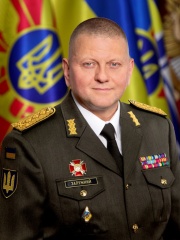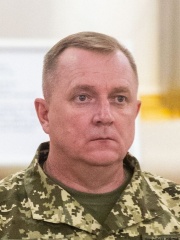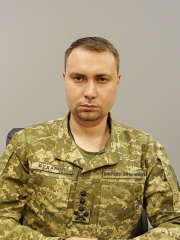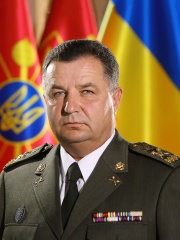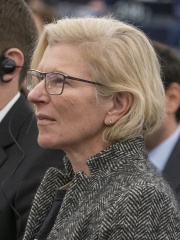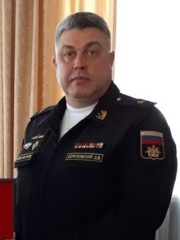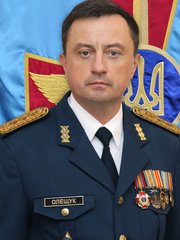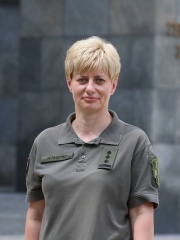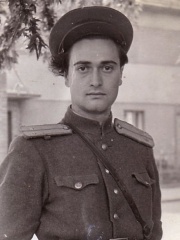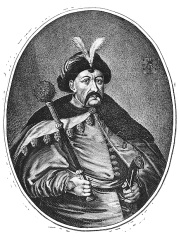
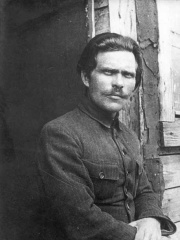
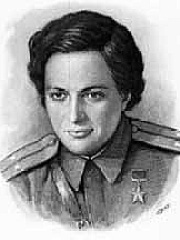
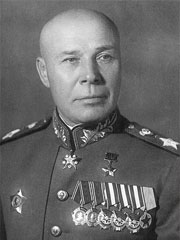
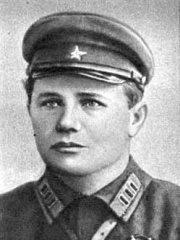
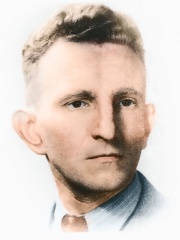
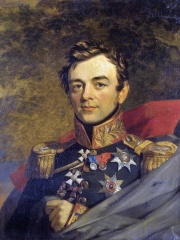
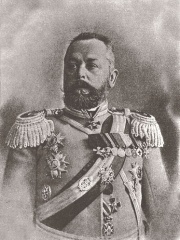
The Most Famous
MILITARY PERSONNELS from Ukraine
This page contains a list of the greatest Ukrainian Military Personnels. The pantheon dataset contains 2,058 Military Personnels, 62 of which were born in Ukraine. This makes Ukraine the birth place of the 9th most number of Military Personnels behind Poland, and China.
Top 10
The following people are considered by Pantheon to be the top 10 most legendary Ukrainian Military Personnels of all time. This list of famous Ukrainian Military Personnels is sorted by HPI (Historical Popularity Index), a metric that aggregates information on a biography's online popularity. Visit the rankings page to view the entire list of Ukrainian Military Personnels.

1. Bohdan Khmelnytsky (1595 - 1657)
With an HPI of 78.96, Bohdan Khmelnytsky is the most famous Ukrainian Military Personnel. His biography has been translated into 62 different languages on wikipedia.
Zynoviy Bohdan Mykhailovych Khmelnytsky of the Abdank coat of arms (1595 – 6 August 1657) was a Ruthenian nobleman and military commander of Zaporozhian Cossacks as Hetman of the Zaporozhian Host, which was then under the suzerainty of the Polish–Lithuanian Commonwealth. He led the Cossacks to victory in a successful uprising against the Commonwealth and its magnates (1648–1654) that resulted in the creation of an independent Cossack state in Ukraine. In 1648–1649, the Cossacks under Khmelnytskyi's leadership massacred tens of thousands of Poles and Jews, with more handed over as yasir (slaves) to his Crimean Tatar allies, one of the most traumatic events in Polish and Jewish history. Under his rule of the newly-established Cossack state, the massacres continued until at least 1652. In 1654, Khmelnytsky concluded the Treaty of Pereiaslav with the Russian Tsar and allied the Cossack Hetmanate with Tsardom of Russia, thus placing Ukraine under Russian protection. Khmelnytsky's uprising permanently changed the balance of powers in Europe and would play a significant role in the development of Ukrainian nationalism. Among Ukrainians Khmelnytsky has been lauded as a folk hero and defender of the Orthodox faith, as well as a fighter for Ukrainian independence and founder of the first Ukrainian state; Russian imperial and Soviet propaganda meanwhile promoted him as a "unifier" of Ukraine with Russia. However, even among his compatriots Khmelnytskyi's image remained controversial due to his questionable alliances and harsh policies, which caused the death and enslavement of numerous people.

2. Nestor Makhno (1888 - 1934)
With an HPI of 75.47, Nestor Makhno is the 2nd most famous Ukrainian Military Personnel. His biography has been translated into 64 different languages.
Nestor Ivanovych Makhno (Ukrainian: Нестор Іванович Махно, pronounced [ˈnɛstor iˈwɑnowɪtʃ mɐxˈnɔ]; 7 November 1888 – 25 July 1934), also known as Bat'ko Makhno (Ukrainian: Батько Махно [ˈbɑtʲko mɐxˈnɔ], lit. 'Father Makhno'), was a Ukrainian anarchist revolutionary and the commander of the Revolutionary Insurgent Army of Ukraine during the Ukrainian War of Independence. He established the Makhnovshchina (loosely translated as "Makhno movement"), a mass movement by the Ukrainian peasantry to establish anarchist communism in the country between 1918 and 1921. Initially centered around Makhno's home province of Katerynoslav and hometown of Huliaipole, it came to exert a strong influence over large areas of southern Ukraine, specifically in what is now the Zaporizhzhia Oblast of Ukraine. Anarchists have cited him as an inspiration during his life and into today. Raised by a peasant family and coming of age amid the fervor around the 1905 Revolution, Makhno participated in a local anarchist group and spent seven years imprisoned for his involvement. With his release during the 1917 Revolution, Makhno became a local revolutionary leader in his hometown and oversaw the expropriation and redistribution of large estates to the peasantry. In the Ukrainian Civil War, Makhno sided with the Soviet Russian Bolsheviks against the Ukrainian nationalists and White movement, but his alliances with the Bolsheviks did not last. He rallied Bolshevik support to lead an insurgency, defeating the Central Powers' occupation forces at the Battle of Dibrivka and establishing the Makhnovshchina. Makhno's troops briefly integrated with the Bolshevik Red Army in the 1919 Soviet invasion of Ukraine, but split over differences on the movement's autonomy. Makhno rebuilt his army from the remains of Nykyfor Hryhoriv's forces in western Ukraine, routed the White Army at the Battle of Perehonivka, and captured most of southern and eastern Ukraine, where they again attempted to establish anarchist communism. Makhno's army fought the Bolshevik re-invasion of Ukraine in 1920 until a White Army offensive forced a short-lived Bolshevik–Makhnovist alliance that drove the Whites out of Crimea and ended the Southern Front of the Russian Civil War. The Bolsheviks immediately turned on Makhno, wounding him and driving him westward in August 1921 to Romanian internment camps, Poland, and Europe, before he settled in Paris with his wife and daughter. Makhno wrote memoirs and articles for radical newspapers, playing a role in the development of platformism. He later became alienated from the French anarchist movement. His family continued to be persecuted in the decades following his death of tuberculosis at the age of 45.

3. Lyudmila Pavlichenko (1916 - 1974)
With an HPI of 75.14, Lyudmila Pavlichenko is the 3rd most famous Ukrainian Military Personnel. Her biography has been translated into 54 different languages.
Lyudmila Mikhailovna Pavlichenko (née Belova; 12 July [O.S. 29 June] 1916 – 10 October 1974) was a Soviet sniper in the Red Army during World War II. She is credited with killing 309 enemy combatants, thus being considered as one of the deadliest snipers in history. She served in the Red Army during the siege of Odessa and the siege of Sevastopol, during the early stages of the fighting on the Eastern Front. After she was injured in battle by a mortar shell, she was evacuated to Moscow. After she recovered from her injuries, she trained other Red Army snipers and was a public spokeswoman for the Red Army. In 1942, she toured the United States, Canada, and the United Kingdom. After the war ended in 1945, she was reassigned as a senior researcher for the Soviet Navy. She died of a stroke at the age of 58.

4. Semyon Timoshenko (1895 - 1970)
With an HPI of 74.16, Semyon Timoshenko is the 4th most famous Ukrainian Military Personnel. His biography has been translated into 51 different languages.
Semyon Konstantinovich Timoshenko (18 February [O.S. 6 February] 1895 – 31 March 1970) was a Soviet military commander, Marshal of the Soviet Union, and one of the most prominent Red Army commanders during the Second World War. Born to a Ukrainian family in Bessarabia, Timoshenko was drafted into the Imperial Russian Army and saw action in the First World War as a cavalryman. On the outbreak of the 1917 Russian Revolution he joined the Red Army. He served with distinction during the Russian Civil War of 1917 to 1922 and the subsequent Polish–Soviet War of 1919 to 1921, which brought him into Vladimir Lenin's and Joseph Stalin's favour. Rapidly rising through the ranks, Timoshenko held several regional commands throughout the 1930s and survived the Great Purge of 1936 to 1938. He led the Ukrainian Front during the Soviet invasion of Poland in 1939. In early 1940, Timoshenko took over the command of Soviet troops in the Winter War in Finland from Kliment Voroshilov and turned the tide for the Red Army. In May 1940, he was named a Marshal of the Soviet Union and the People's Commissar for Defence. In the latter capacity, he took steps to modernise the Red Army and to prepare for a likely war with Nazi Germany. On the outbreak of the Axis invasion of the Soviet Union in June 1941 Timoshenko was named chairman of the Stavka. Replaced by Stalin himself a month later, he went on to hold a series of important field commands in the following year. In late 1941, he organised a major counter-offensive in Rostov, which brought him international renown. His fortunes had faltered by mid-1942, in particular after the overwhelming Soviet defeat at the Second Battle of Kharkov, and he was relieved from the command of the newly formed Stalingrad Front. He was recalled later that year and appointed commander of the Northwestern Front, and as a Stavka representative he oversaw and coordinated the activities of several fronts in various times during the last phase of the war, including the Leningrad, Volkhov, and North Caucasus Fronts and the Black Sea Fleet, and the 2nd and 3rd Ukrainian fronts. After the war, Timoshenko held commands in several Soviet military districts until his effective retirement in 1960. He died in 1970 at the age of 75.
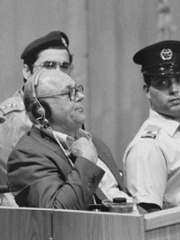
5. John Demjanjuk (1920 - 2012)
With an HPI of 70.24, John Demjanjuk is the 5th most famous Ukrainian Military Personnel. His biography has been translated into 37 different languages.
John Demjanjuk (born Ivan Mykolaiovych Demjanjuk 3 April 1920 – 17 March 2012), was a Trawniki and Nazi camp guard at Sobibor extermination camp, Majdanek, and Flossenbürg. Demjanjuk became the center of global media attention in the 1980s, when he was tried and convicted in Israel after being identified as "Ivan the Terrible", a notoriously cruel watchman at Treblinka extermination camp. Demjanjuk was sentenced to death by hanging in 1988. In 1993, the verdict was overturned. Shortly before his death, he was tried and convicted in the Federal Republic of Germany as an accessory to the 28,060 murders that occurred during his service at Sobibor. Born in Soviet Ukraine, Demjanjuk was conscripted into the Red Army in 1940. He fought in World War II and was taken prisoner by the Germans in spring 1942, becoming a Trawniki collaborator. After training, he served at Sobibor extermination camp and at least two concentration camps. After the war, he married a woman he met in a West German displaced persons camp, and emigrated with her and their daughter to the United States. They settled in Seven Hills, Ohio, where he worked in an auto factory and raised three children. Demjanjuk became a US citizen in 1958. In 1977, Demjanjuk was accused of war crimes. Based on eyewitness testimony by Holocaust survivors in Israel, he was identified as the notorious Ivan the Terrible from Treblinka. Demjanjuk was extradited to Israel in 1986 for trial. In 1988, Demjanjuk was convicted and sentenced to death. He maintained his innocence, claiming that it was a case of mistaken identity. In 1993, the verdict was overturned by the Israeli Supreme Court, based on new evidence that cast reasonable doubt over his identity as Ivan the Terrible. Although the judges agreed there was sufficient evidence to show that Demjanjuk had served at Sobibor, Israel declined to prosecute. In September 1993, Demjanjuk was allowed to return to Ohio. In 1999, US prosecutors again sought to deport Demjanjuk for having been a concentration camp guard, and his citizenship was revoked in 2002. In 2009, Germany requested his extradition for over 27,900 counts of acting as an accessory to murder, one for each person killed at Sobibor during the time when he was alleged to have served there as a guard. He was deported from the US to Germany in that same year. In 2011, he was convicted and sentenced to five years in prison. According to legal scholar Lawrence Douglas, in spite of serious missteps along the way, the German verdict brought the case "to a worthy and just conclusion". After the conviction, Demjanjuk was released pending appeal. He lived at a German nursing home in Bad Feilnbach, where he died in 2012. Having died before a final judgment on his appeal could be issued, Demjanjuk remains technically innocent under German law. In 2020, a photograph album by Sobibor guard Johann Niemann was made public; some historians have suggested that a guard who appears in two photos may have been Demjanjuk.

6. Andrey Yeryomenko (1892 - 1970)
With an HPI of 69.89, Andrey Yeryomenko is the 6th most famous Ukrainian Military Personnel. His biography has been translated into 42 different languages.
Andrey Ivanovich Yeryomenko (Russian: Андре́й Ива́нович Ерёменко; Ukrainian: Андрій Іванович Єрьоменко; October 14 [O.S. October 2] 1892 – November 19, 1970) was a Soviet general during World War II and Marshal of the Soviet Union. During the war, Yeryomenko commanded the Southeastern Front (later renamed the Stalingrad Front) during the Battle of Stalingrad in summer 1942 and planned the successful defense of the city. He later commanded the armies responsible for the occupation of Western Hungary and Eastern Czechoslovakia in 1945.

7. Roman Shukhevych (1907 - 1950)
With an HPI of 69.79, Roman Shukhevych is the 7th most famous Ukrainian Military Personnel. His biography has been translated into 28 different languages.
Roman-Taras Osypovych Shukhevych (Ukrainian: Роман-Тарас Осипович Шухевич, also known by his pseudonym, Tur and Taras Chuprynka; 30 June 1907 – 5 March 1950) was a Ukrainian nationalist and a military leader of the nationalist Ukrainian Insurgent Army (UPA), which during the Second World War fought against the Soviet Union and to a lesser extent against Nazi Germany for Ukrainian independence. He collaborated with the Nazis from February 1941 to December 1942 as commanding officer of the Nachtigall Battalion in early 1941, and as a Hauptmann of the German Schutzmannschaft 201 auxiliary police battalion in late 1941 and 1942. Shukhevych led some of the Galicia-Volhynia massacres, where tens of thousands of Polish civilians were killed. It is unclear to what extent Shukhevych was responsible for the massacres of Poles in Volhynia, but he condoned them afterwards, and directed the murders of Poles in Eastern Galicia. Historian Per Anders Rudling has accused the Ukrainian diaspora and Ukrainian academics of "ignoring, glossing over, or outright denying" OUN's role in the massacres.

8. Ivan Paskevich (1782 - 1856)
With an HPI of 69.59, Ivan Paskevich is the 8th most famous Ukrainian Military Personnel. His biography has been translated into 36 different languages.
Count Ivan Fyodorovich Paskevich-Erevansky, Serene Prince of Warsaw (19 May [O.S. 8 May] 1782 – 1 February [O.S. 20 January] 1856) was a Russian military leader who was the namiestnik of Poland. Paskevich is known for leading Russian forces in Poland during the November Uprising and for a series of leadership roles throughout the early and mid-19th century, such as the Russo-Persian War of 1826–1828, and the beginning phase of the Crimean War. In Russian history, he is remembered as a prominent military commander, rated on a par with Ivan Dibich-Zabalkansky, commander of the Russian armies during the same time. Paskevich started as an officer during the Napoleonic Wars serving in the battles of Austerlitz and Borodino. After the war, he was a leader in the Russo-Persian War. He was made count of Yerevan in 1828. Afterwards, he became the namiestnik of Poland in 1831 after he crushed the Polish rebels in the November Uprising. He then helped crush the Hungarian Revolution of 1848. His last engagement was the Crimean War. Paskevich died in Warsaw in 1856. He attained the rank of field marshal in the Russian army, and later in the Prussian and Austrian armies.

9. Alexander Samsonov (1859 - 1914)
With an HPI of 68.55, Alexander Samsonov is the 9th most famous Ukrainian Military Personnel. His biography has been translated into 33 different languages.
Alexander or Aleksandr Vasilyevich Samsonov (Russian: Алекса́ндр Васи́льевич Самсо́нов, tr. Aleksándr Vasíl’evič Samsónov; 14 November [O.S. 2 November] 1859 – 30 August [O.S. 17 August] 1914) was a career officer in the cavalry of the Imperial Russian Army and a general during the Russo-Japanese War and World War I. He was the commander of the Russian Second Army which was surrounded and defeated by the German Eighth Army in the Battle of Tannenberg, one of the early battles of World War I. Ashamed by his loss of the Army, Samsonov committed suicide while retreating from the battlefield.
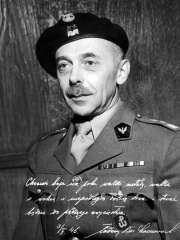
10. Tadeusz Bór-Komorowski (1895 - 1966)
With an HPI of 68.32, Tadeusz Bór-Komorowski is the 10th most famous Ukrainian Military Personnel. His biography has been translated into 37 different languages.
Generał Tadeusz Komorowski (1 June 1895 – 24 August 1966), better known by the name Bór-Komorowski (after one of his wartime code names: Bór – "The Forest") was a Polish military leader. He was appointed commander-in-chief a day before the capitulation of the Warsaw Uprising and following World War II, 32nd Prime Minister of Poland, 3rd Polish government-in-exile in London.
People
Pantheon has 62 people classified as Ukrainian military personnels born between 1395 and 1996. Of these 62, 9 (14.52%) of them are still alive today. The most famous living Ukrainian military personnels include Valerii Zaluzhnyi, Serhiy Shaptala, and Kyrylo Budanov. The most famous deceased Ukrainian military personnels include Bohdan Khmelnytsky, Nestor Makhno, and Lyudmila Pavlichenko. As of April 2024, 4 new Ukrainian military personnels have been added to Pantheon including Yuri Budanov, Mykola Oleshchuk, and Dmytro Kotsiubailo.
Living Ukrainian Military Personnels
Go to all RankingsValerii Zaluzhnyi
1973 - Present
HPI: 63.85
Serhiy Shaptala
1973 - Present
HPI: 55.99
Kyrylo Budanov
1986 - Present
HPI: 52.33
Stepan Poltorak
1965 - Present
HPI: 51.51
Yuliia Paievska
1968 - Present
HPI: 50.66
Denis Berezovsky
1974 - Present
HPI: 49.63
Mykola Oleshchuk
1972 - Present
HPI: 47.74
Tetiana Ostashchenko
1974 - Present
HPI: 44.93
Yaryna Chornohuz
1995 - Present
HPI: 32.24
Deceased Ukrainian Military Personnels
Go to all RankingsBohdan Khmelnytsky
1595 - 1657
HPI: 78.96
Nestor Makhno
1888 - 1934
HPI: 75.47
Lyudmila Pavlichenko
1916 - 1974
HPI: 75.14
Semyon Timoshenko
1895 - 1970
HPI: 74.16
John Demjanjuk
1920 - 2012
HPI: 70.24
Andrey Yeryomenko
1892 - 1970
HPI: 69.89
Roman Shukhevych
1907 - 1950
HPI: 69.79
Ivan Paskevich
1782 - 1856
HPI: 69.59
Alexander Samsonov
1859 - 1914
HPI: 68.55
Tadeusz Bór-Komorowski
1895 - 1966
HPI: 68.32
Vladimir Gelfand
1923 - 1983
HPI: 68.10
Alfred Redl
1864 - 1913
HPI: 67.33
Newly Added Ukrainian Military Personnels (2025)
Go to all RankingsYuri Budanov
1963 - 2011
HPI: 50.61
Mykola Oleshchuk
1972 - Present
HPI: 47.74
Dmytro Kotsiubailo
1995 - 2023
HPI: 40.56
Yaryna Chornohuz
1995 - Present
HPI: 32.24
Overlapping Lives
Which Military Personnels were alive at the same time? This visualization shows the lifespans of the 25 most globally memorable Military Personnels since 1700.

